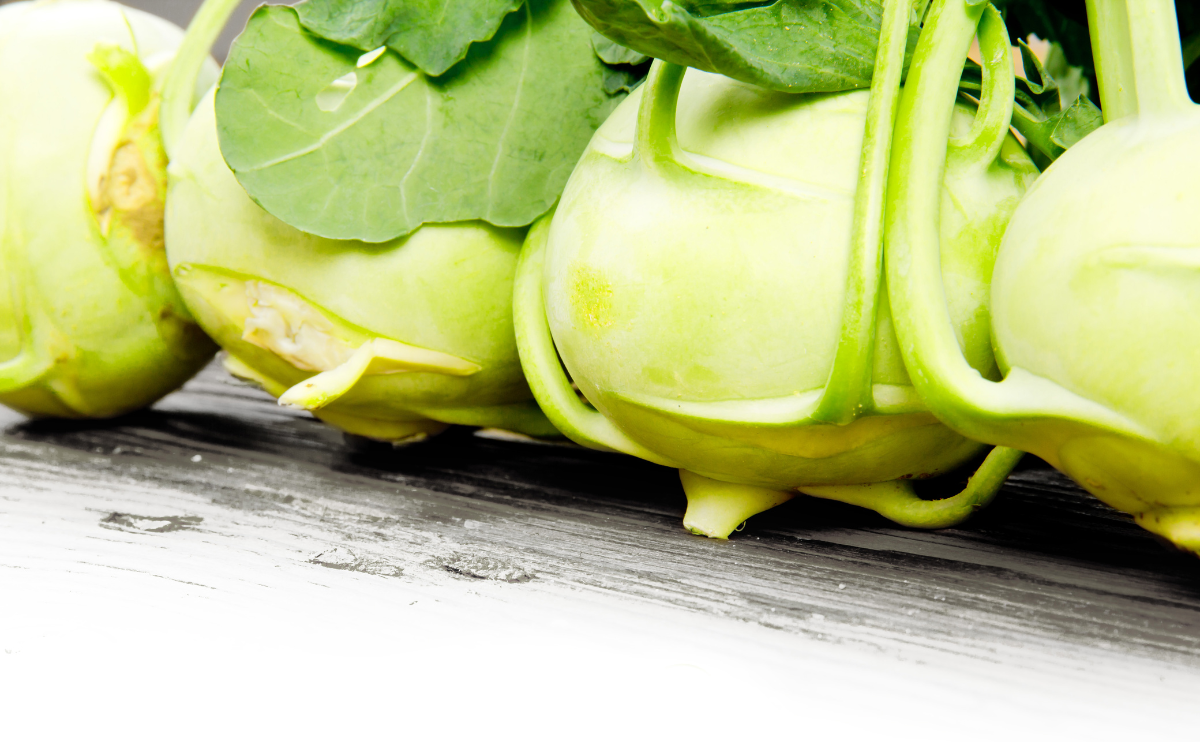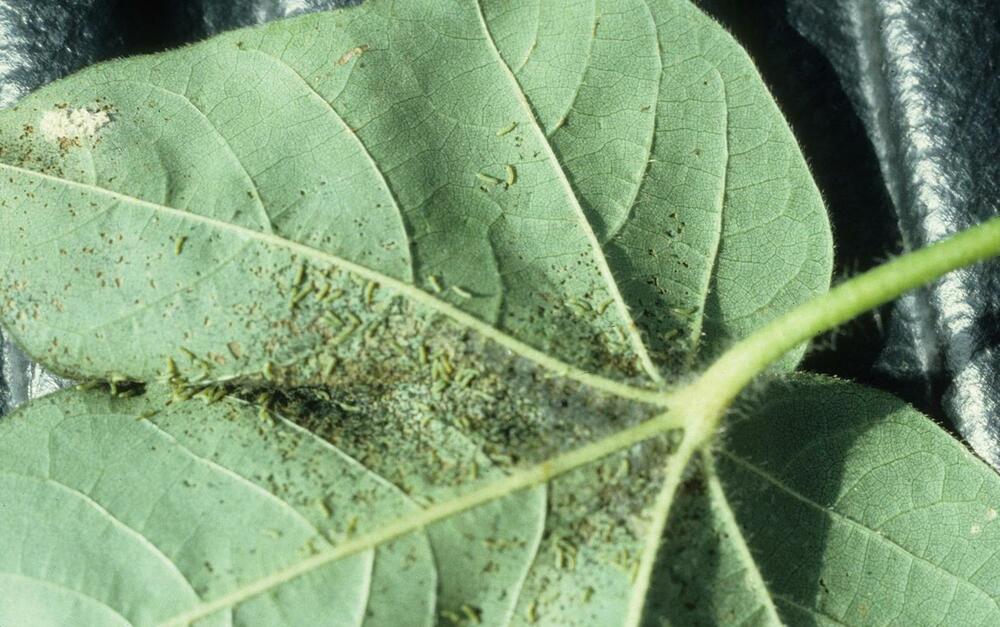For many people, kohlrabi (Brassica oleracea) is one of those novelty vegetables you encounter in the produce aisle. It looks interesting but unfamiliar, and you pass it by. However, kohlrabi is a versatile vegetable you can use in recipes as a substitute for broccoli or cabbage. The name means cabbage-turnip, which is a clue to its flavor. When eaten raw, the young stems are crisp and mild. When used in recipes, kohlrabi is like cabbage 2.0: vegetal, but slightly spicy.
Kohlrabi reaches harvest maturity 45 to 60 days after the seeds germinate. Ideally, you should plant it so it comes to harvest before average daytime temperatures exceed 75 degrees Fahrenheit. If you plan to harvest it as a fall crop, you can plant the seeds about 90 days before the expected first frost date.

| Botanical Name | Brassica oleracea |
| Common Names | Kohlrabi; German turnip, Turnip-rooted cabbage |
| Plant Type | Herbaceous biennial |
| Mature Size | 18 inches tall, 18 to 24 inches wide |
| Sun Exposure | Full sun |
| Soil Type | Rich, moist loam |
| Soil pH | Slightly acidic (5.5 to 6.9) |
| Bloom Time | Summer |
| Flower Color | Pale yellow |
| Hardiness Zones | 2a to 11b (USDA) |
| Native Area | Northern Europe |

When to Plant?
This will be determined by your planting zone. There is a final frost date for each area. As a result, you can plan your gardening activities around this date. Check our Frost Dates Across North America: First & Last Frost Dates Chart. However, the date will not be the same for every plant.
How to Plant
Plant kohlrabi in full sun. Grow kohlrabi in well-worked, well-drained soil rich in organic matter. Work 2 inches (5cm) of aged compost into the soil before you begin planting.Kohlrabi prefers soil within the 5.5 to 6.8 range. Side dress kohlrabi with aged compost at midseason.

Indoor starting: Kohlrabi seeds can be started indoors or in a cold frame or plastic tunnel. Sow kohlrabi seed ½ inch deep and 1 inch (2.5 cm) apart; thin successful seedlings from 5 to 8 inches (12-20cm) apart. Space rows 18 to 24 inches (45-60 cm) apart. Thinned seedlings can be transplanted to another part of the garden. Intensive spacing: Sow seed or set out transplants 4 to 6 inches (10-15cm) apart in a staggered double row.
How to Cultivate
Keep soil evenly moist for quick growth. Kohlrabi that goes without water will become woody.
Prepare planting beds with aged compost.
How to Harvest
Kohlrabi is ready for harvest when stem globes reach 2 to 3 inches (5-7cm) in diameter.
Globes that grow larger than 3 inches (7.5cm) in diameter may become woody.
Hydroponics
Germination: Soak kohlrabi seeds in water for 6-8 hours before sowing. Place the soaked seeds in a small pot filled with a germination medium like rockwool or coco coir. Water the seeds regularly and keep the pot in a warm and well-lit area. The seeds should germinate in about 4-7 days.
pH range: The pH range for hydroponic kohlrabi should be between 6.0-6.5. Maintaining the correct pH level is important for the plants to absorb the necessary nutrients.
EC: The electrical conductivity (EC) level should be maintained at around 1.2-2.2 mS/cm for hydroponic kohlrabi. This helps to ensure that the plants receive the right amount of nutrients.
PPM: The parts per million (PPM) for hydroponic kohlrabi should be around 800-1600 ppm. This measures the concentration of nutrients in the water solution.
Humidity: The humidity level should be maintained at around 50-60% for kohlrabi to grow properly. This can be achieved by using a humidifier or by placing a tray of water near the plants.
Light hours: Kohlrabi requires about 12-16 hours of light per day for optimal growth. You can use artificial lights like LED grow lights to provide the necessary light if natural light is not available.
Temperature air: The air temperature should be maintained at around 18-24°C (64-75°F) during the day and around 15-18°C (59-64°F) at night for kohlrabi to grow well.
Temperature water: The water temperature should be maintained at around 18-22°C (64-72°F) for hydroponic kohlrabi. This helps to ensure that the plants absorb the necessary nutrients.
Overall, growing kohlrabi hydroponically can be a rewarding experience, and following these guidelines can help you grow healthy and vibrant plants.
Hydroponics
Germination: Soak kohlrabi seeds in water for 6-8 hours before sowing. Place the soaked seeds in a small pot filled with a germination medium like rockwool or coco coir. Water the seeds regularly and keep the pot in a warm and well-lit area. The seeds should germinate in about 4-7 days.
pH range: The pH range for hydroponic kohlrabi should be between 6.0-6.5. Maintaining the correct pH level is important for the plants to absorb the necessary nutrients.
EC: The electrical conductivity (EC) level should be maintained at around 1.2-2.2 mS/cm for hydroponic kohlrabi. This helps to ensure that the plants receive the right amount of nutrients.
PPM: The parts per million (PPM) for hydroponic kohlrabi should be around 800-1600 ppm. This measures the concentration of nutrients in the water solution.
Humidity: The humidity level should be maintained at around 50-60% for kohlrabi to grow properly. This can be achieved by using a humidifier or by placing a tray of water near the plants.
Light hours: Kohlrabi requires about 12-16 hours of light per day for optimal growth. You can use artificial lights like LED grow lights to provide the necessary light if natural light is not available.
Temperature air: The air temperature should be maintained at around 18-24°C (64-75°F) during the day and around 15-18°C (59-64°F) at night for kohlrabi to grow well.
Temperature water: The water temperature should be maintained at around 18-22°C (64-72°F) for hydroponic kohlrabi. This helps to ensure that the plants absorb the necessary nutrients.
Overall, growing kohlrabi hydroponically can be a rewarding experience, and following these guidelines can help you grow healthy and vibrant plants.



